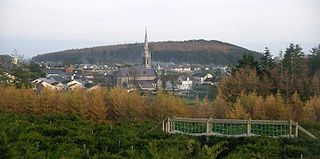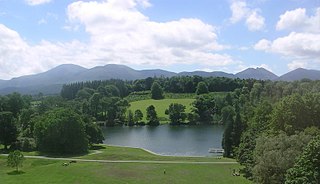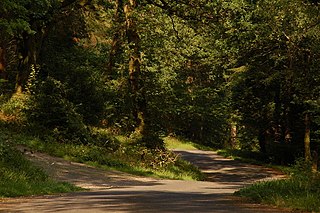
Newcastle is a small seaside resort town in County Down, Northern Ireland, which had a population of 8,298 at the 2021 Census. It lies by the Irish Sea at the foot of Slieve Donard, the highest of the Mourne Mountains. Newcastle is known for its sandy beach, forests, and mountains. The town lies within the Newry, Mourne and Down District.

County Down is one of the six counties of Northern Ireland, one of the nine counties of Ulster and one of the traditional thirty-two counties of Ireland. It covers an area of 961 sq mi (2,490 km2) and has a population of 552,261. It borders County Antrim to the north, the Irish Sea to the east, County Armagh to the west, and County Louth across Carlingford Lough to the southwest.

Earl of Roden is a title in the Peerage of Ireland. It was created in 1771 for Robert Jocelyn, 2nd Viscount Jocelyn. This branch of the Jocelyn family descends from the 1st Viscount, prominent Irish lawyer and politician Robert Jocelyn, the son of Thomas Jocelyn, third son of Sir Robert Jocelyn, 1st Baronet, of Hyde Hall. He notably served as the Lord Chancellor of Ireland from 1739 to 1756. In 1743, he was raised to the Peerage of Ireland as Baron Newport, of Newport, and in 1755 he was further honoured, when he was made Viscount Jocelyn, also in the Peerage of Ireland. He was succeeded by his son, the second Viscount. He represented Old Leighlin in the Irish House of Commons and served as Auditor-General of Ireland. In 1770 he also succeeded his first cousin once removed as fifth Baronet of Hyde Hall. In 1771 he was created Earl of Roden, of High Roding in the County of Tipperary, in the Peerage of Ireland. Lord Roden married Lady Anne Hamilton, daughter of James Hamilton, 1st Earl of Clanbrassil and sister of James Hamilton, 2nd Earl of Clanbrassil, a title which became extinct in 1798.

The Mourne Mountains, also called the Mournes or Mountains of Mourne, are a granite mountain range in County Down in the south-east of Northern Ireland. They include the highest mountains in Northern Ireland, the highest of which is Slieve Donard at 850 m (2,790 ft). The Mournes are designated an Area of Outstanding Natural Beauty and it has been proposed to make the area Northern Ireland's first national park. The area is partly owned by the National Trust and sees many visitors every year. The Mourne Wall crosses fifteen of the summits and was built to enclose the catchment basin of the Silent Valley and Ben Crom reservoirs.

Castlewellan is a small town in County Down, in the south-east of Northern Ireland close to the Irish Sea. It is beside Castlewellan Lake and Slievenaslat mountain, 11 miles (18 km) southwest of Downpatrick. It lies between the Mourne Mountains and Slieve Croob. It had a population of 2,782 people in the 2011 census.
The Rt Rev. and Hon. Percy Jocelyn was Anglican Bishop of Clogher in the Church of Ireland from 1820 to 1822. He was forced from his position due to being caught in homosexual practices, which had been outlawed under the Buggery Act 1533.

Earl of Clanbrassil was a title that was created twice in the Peerage of Ireland, both times for members of the Hamilton family. Clanbrassil was the name of an old Gaelic territory in what is now the barony of Oneilland East in the north-east of modern County Armagh, Northern Ireland.

Bryansford is a small village in County Down, Northern Ireland. It sits at the northern side of Tollymore Forest Park, roughly halfway between the towns of Newcastle and Castlewellan. The village is within the townlands of Ballyhafry and Aghacullion, in the Civil parish of Kilcoo. It had a population of 392 people in the 2001 Census.

The Shimna River is a river in County Down, Northern Ireland. It rises on the slopes of Ott Mountain, in the Mourne Mountains, and enters the Irish Sea at Newcastle, on Dundrum Bay. It is acidic and nutrient-poor, as a result of which its most common flora are mosses and liverworts, including the rare Portuguese feather-moss and Holt's mouse-tail moss. Its principal fish are salmon and sea trout, and it is managed by the Shimna Angling Club. The river is an Area of Special Scientific Interest (ASSI).

Robert Jocelyn, 3rd Earl of Roden,, styled Viscount Jocelyn between 1797 and 1820, was an Irish Tory politician and supporter of Protestant causes.
Robert Jocelyn, 2nd Earl of Roden KP, PC (Ire) was an Irish peer, soldier and politician. He was styled The Honourable from his birth to 1771, and then Viscount Jocelyn from 1771 to 1797. He was the eldest son of the 1st Earl of Roden and Lady Anne Hamilton, daughter of James Hamilton, 1st Earl of Clanbrassil.

Gustavus Hamilton, 2nd Viscount Boyne PC (Ire) (1710–1746) was an Irish politician and an enthusiastic admirer of Italy and the Carnival of Venice.
Robert Jocelyn, 1st Earl of Roden was an Irish peer and politician. He was the only son of Robert Jocelyn, 1st Viscount Jocelyn and his first wife Charlotte Anderson.
James Hamilton, 1st Earl of Clanbrassil PC(I) was a British politician and peer.
John Strange Jocelyn, 5th Earl of Roden, was an Anglo-Irish soldier and representative peer. He was the son of Robert Jocelyn, 3rd Earl of Roden, and inherited the title after the death of his nephew Robert Jocelyn, 4th Earl of Roden, in 1880.
The Custos Rotulorum of Louth was the highest civil officer in County Louth.

Castlewellan Forest Park is located in the town of Castlewellan in County Down, Northern Ireland.

Annalong Forest is located near the village of Annalong in County Down, Northern Ireland. It is made up of two sections: Annalong Wood and Silent Valley. The forest consists of various species of conifer. It is part of the Mourne Area of Outstanding Natural Beauty. There have been two major forest fires in the area since 2011. One, which started on 30 April 2011, required 10 fire engines to extinguish and caused the temporary closure of several roads. Another, on 24 April 2010, destroyed approximately 50 hectares of gorse and was believed to have been started deliberately.

Donard Forest is located near Newcastle, County Down, Northern Ireland. It borders Donard Park at the foot of the Mourne Mountains. The Glen River flows through the forest where it is crossed by three stone bridges. The north east section of the forest contains a Heritage Stand of Scots and Corsican pine planted in 1927. A south east section, beside the Glen River, was the former site of Donard Lodge. The lodge was built in the 1830s by the Annesley family and demolished in 1966 after falling into ruin. The Annesleys planted a number of exotic trees in the area surrounding the house, including Giant Redwoods and Monkey Puzzles. There is also a small stone shelter, built in 1842, a short distance from the river.

Rostrevor Forest is located near the village of Rostrevor, County Down, Northern Ireland. It lies between the Mourne Mountains and Carlingford Lough, in the Mourne Area of Outstanding Natural Beauty. The first trees, primarily sitka spruce, douglas fir and pine, were planted in 1931. The Forest Service carries out felling in the forest and replants trees with wildlife conservation in mind. Animal species found in the forest include red and grey squirrels, foxes, badgers, jays and sparrow hawks.




















